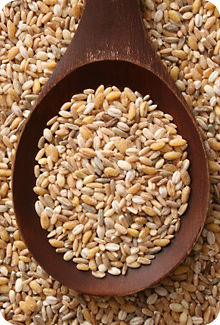Gluten-related disorders and celiac disease

Gluten-related disorders is a term used to describe all conditions related to the consumption of gluten. Celiac disease and wheat allergy are the most well-known of the gluten-related disorders. For more information on wheat allergy, please consult Health Canada's pamphlet "Wheat & Triticale – Priority allergens".
Celiac disease is a different disease than an allergy. It is a chronic immune-mediated intestinal disease in genetically predisposed individuals. This disease is triggered by the consumption of gluten proteins from wheat, rye, barley and triticale (a cross between wheat and rye) and result in damage to the small intestine that can lead, if not treated, to long-term complications and an increased risk of certain cancers. The only current treatment for celiac disease is to continually maintain a strict gluten-free diet.
Gluten sources
Gluten are proteins found in the grains of certain cereals (and hybrid crops grown from those cereals):
- Barley
- Rye
- Triticale
- Wheat
- Oats
Did you know…
As oats generally contain small amounts of barley, wheat or rye due to agricultural practices, oats are also identified as a potential source of gluten. Most people with celiac disease can however safely consume gluten-free oats.
Fast facts
Celiac disease affects nearly one percent of the population but many remain undiagnosed. In the past, celiac disease was thought to be a childhood disease, but it is now recognized that it occurs more frequently in adults, especially in individuals between 30 and 60 years of age.
Symptoms of celiac disease
Celiac disease can be hard to diagnose because the symptoms (and their severity) can be very different from one person to the next. The symptoms can develop at any age. Abdominal pain and growth impairment are currently the major symptoms in children. In adults, gastrointestinal complaints are common and include abdominal pain and diarrhea but sometimes constipation. Only some individuals with celiac disease have gastrointestinal symptoms while others complain of fatigue or may have depression. Some have no obvious symptoms and present with anemia (related to iron or folate deficiency) and osteoporosis (decreased bone mass).
Celiac disease is diagnosed through a combination of blood tests, small-bowel biopsy and recovery from symptoms with a gluten-free diet.
Maintaining a gluten-free diet is the only way to avoid the symptoms and the complications of celiac disease. To know more about symptoms and diagnosis of this disease or about other gluten-related disorders and gluten sources in the diet, please consult Health Canada's information pamphlets:
- Celiac Disease: The Gluten Connection
- Gluten – A group of proteins people with gluten-related disorders should avoid
For more information
- Food allergies
- Food allergies and intolerances
- Canadian Celiac Association (CCA)
- Fondation québécoise de la maladie coeliaque - available in French only (FQMC)
- Food Safety
- Food Safety Tips - CFIA
- The Consumer's Role
Advisories and Warnings
- Food recalls and advisories (Government of Canada)
- Food Recalls and Allergy Alerts (CFIA)